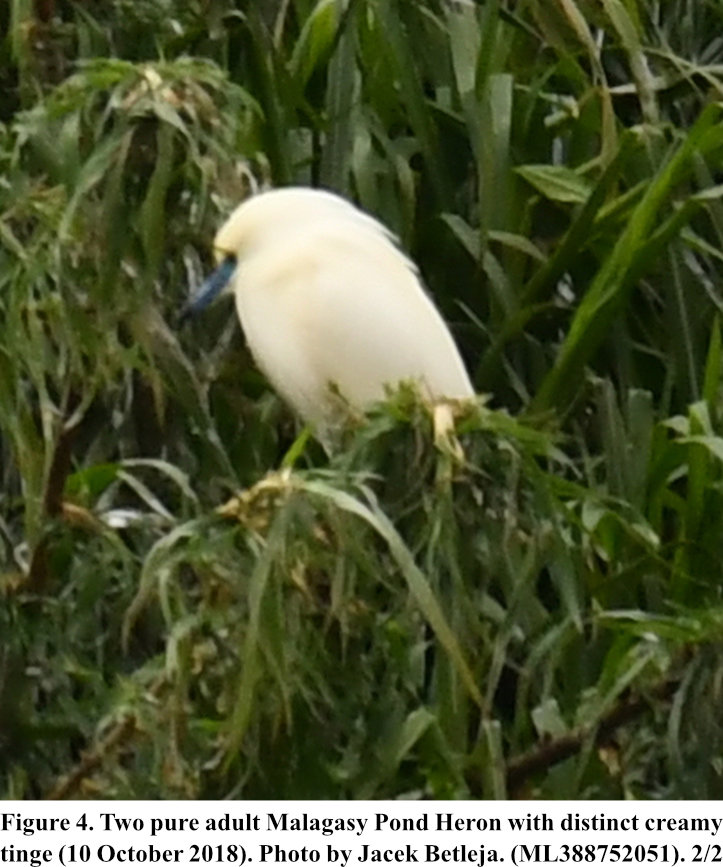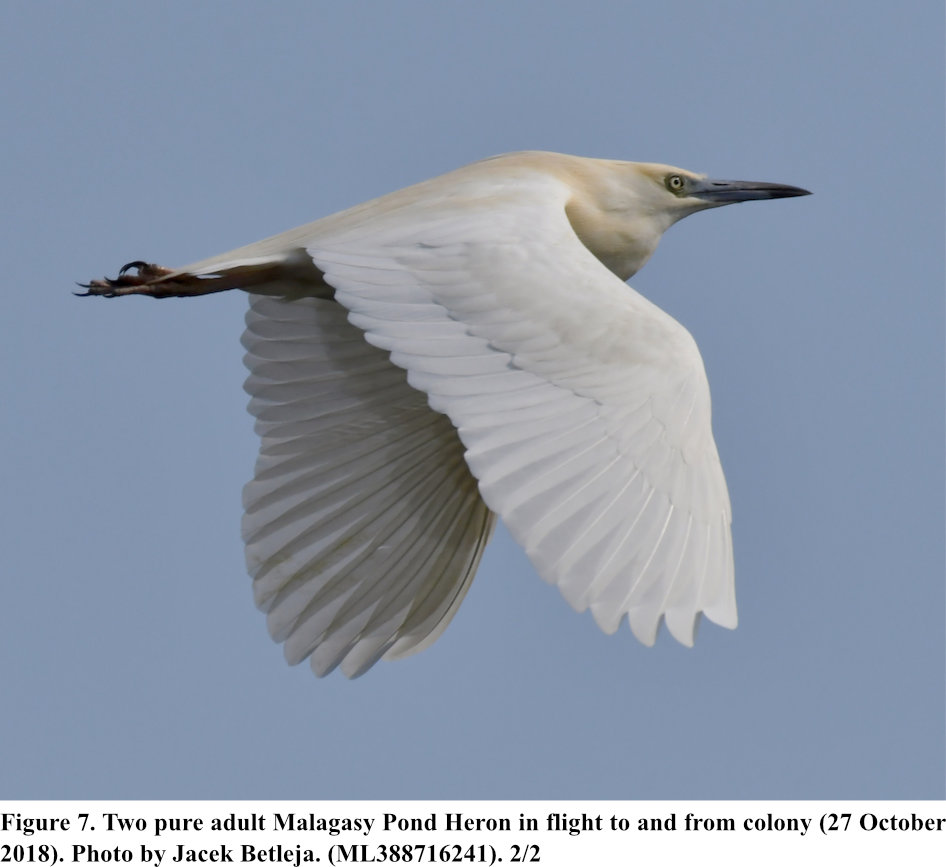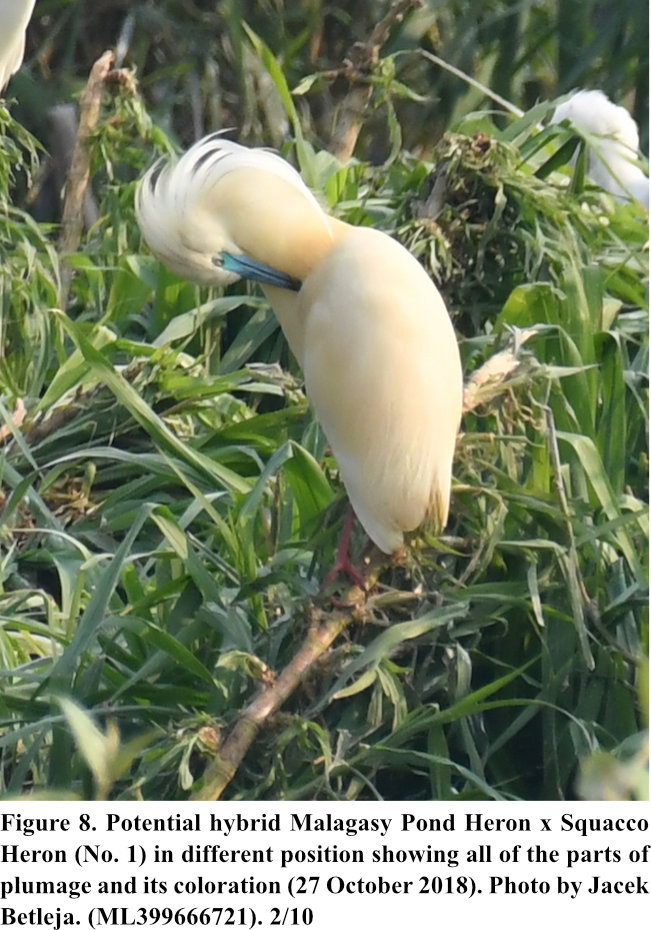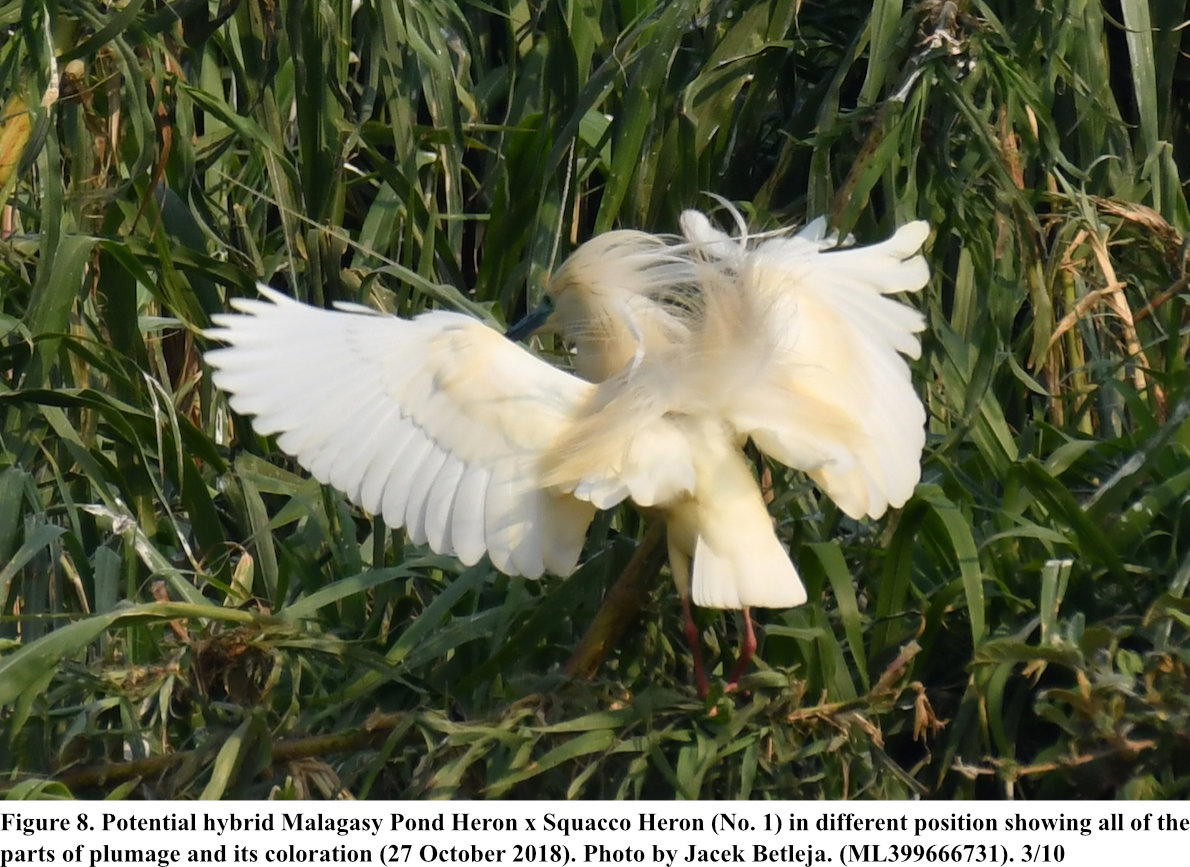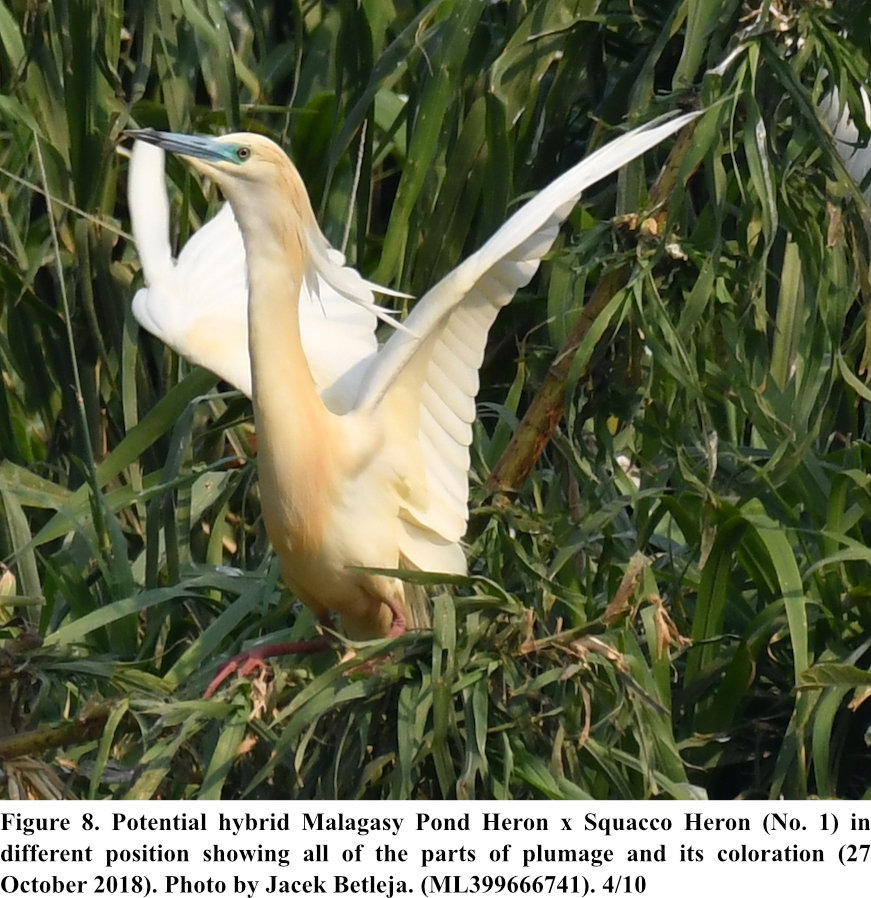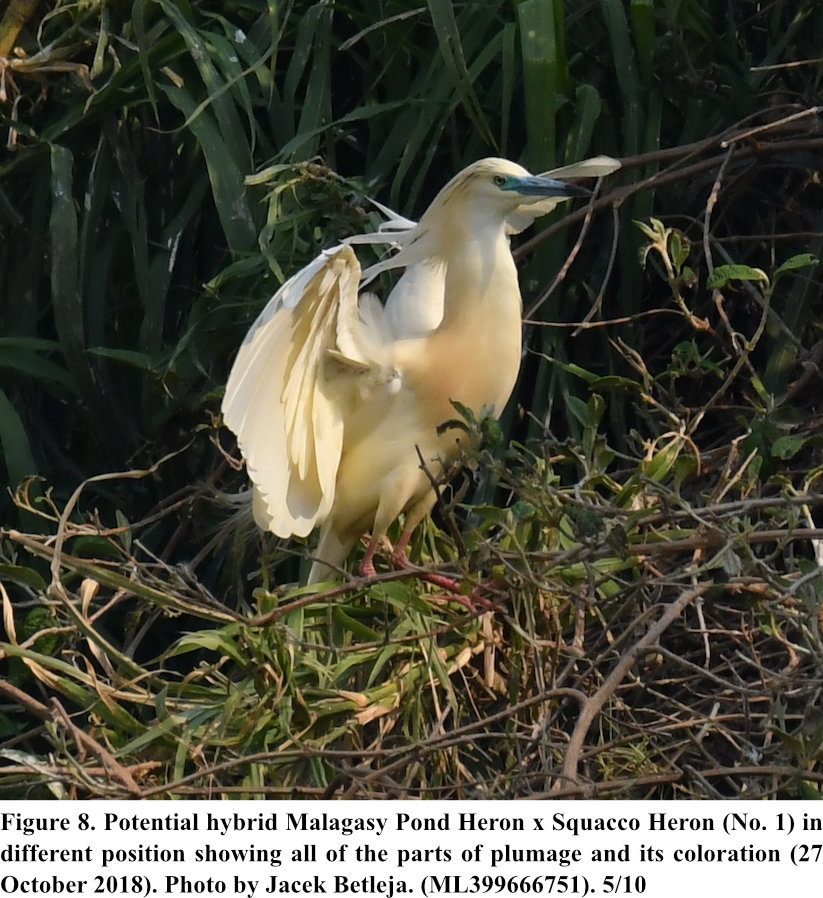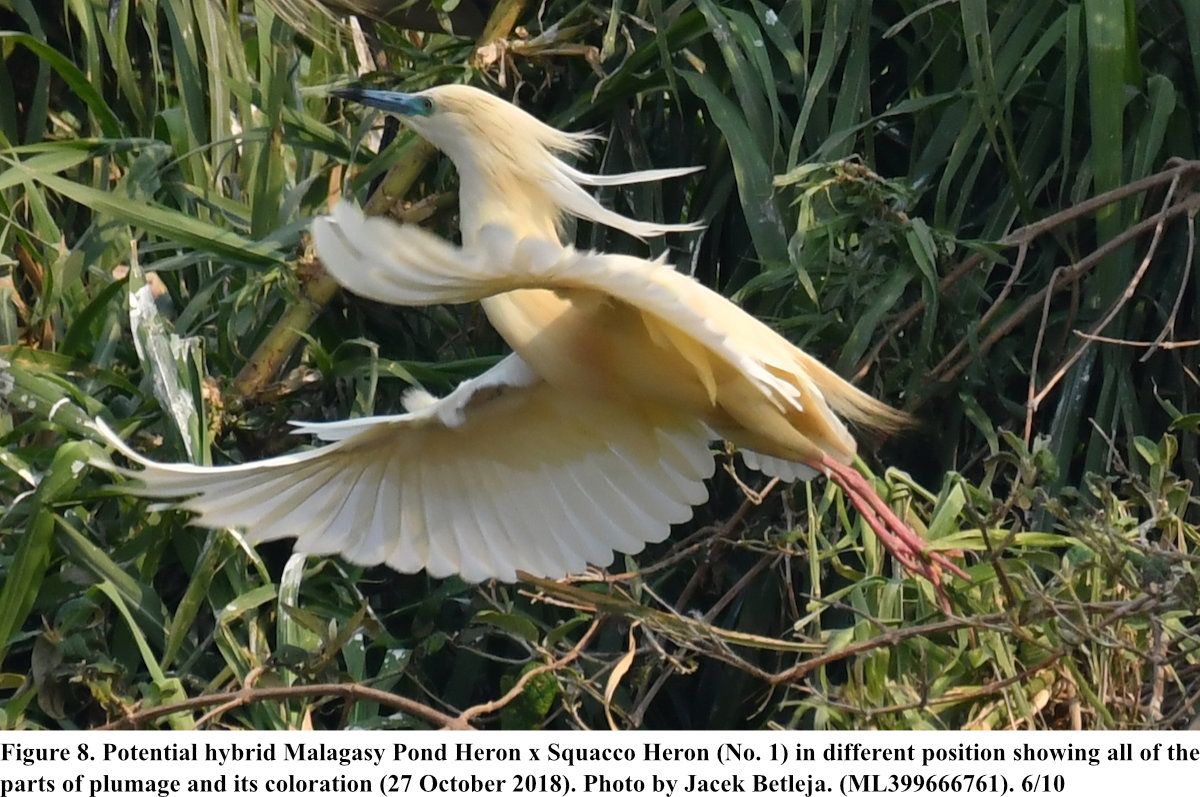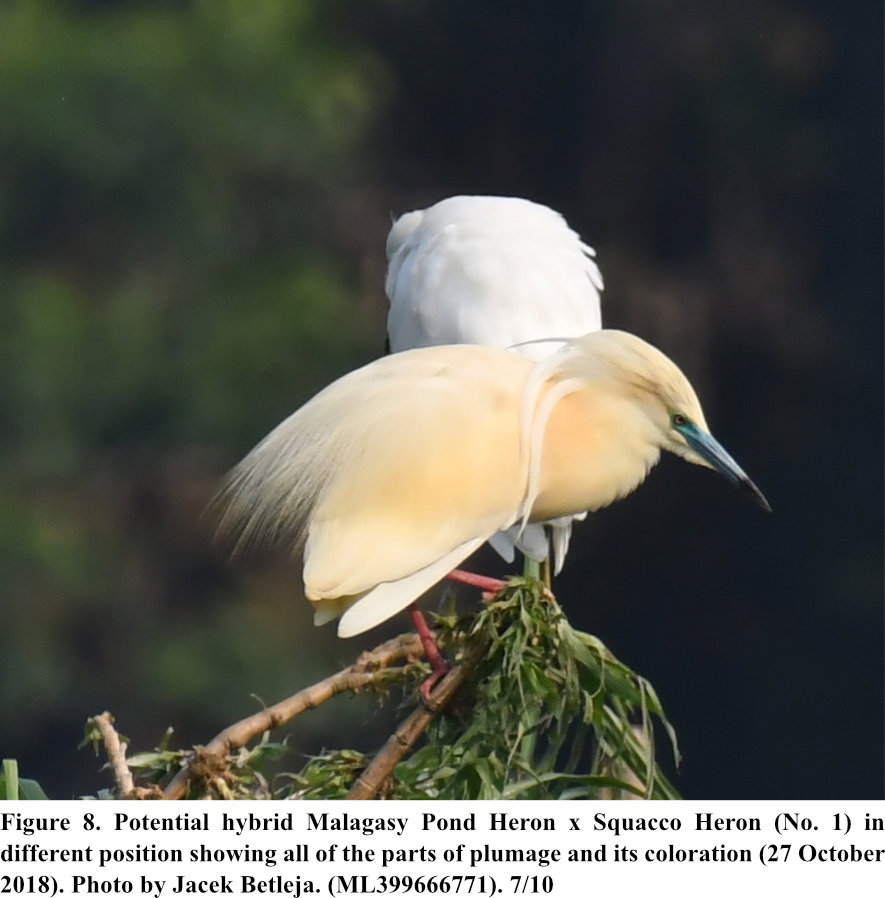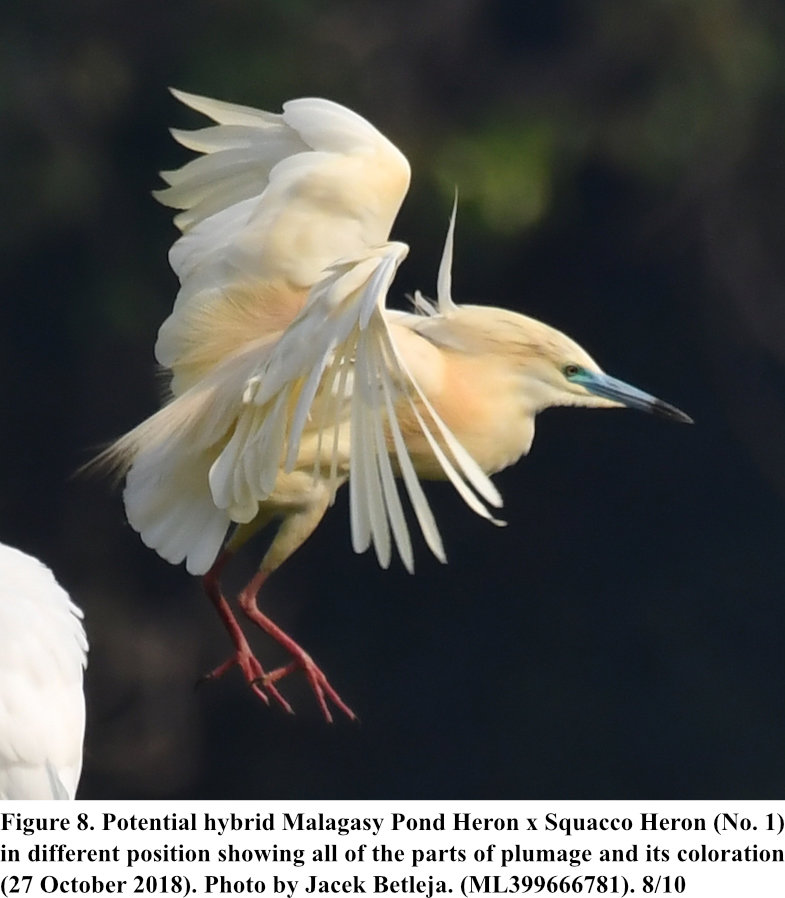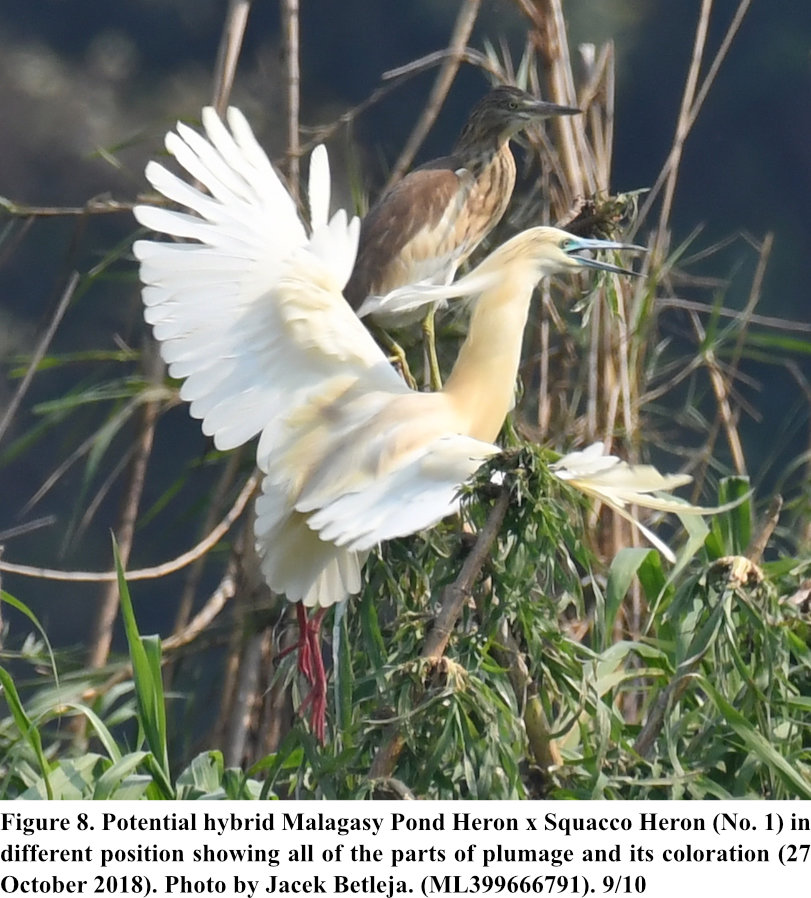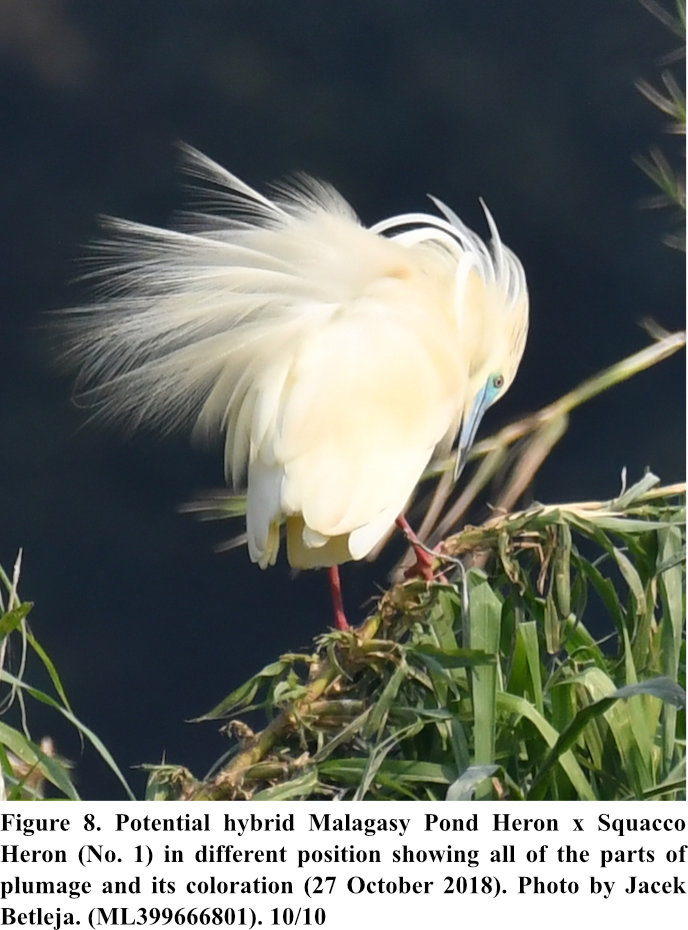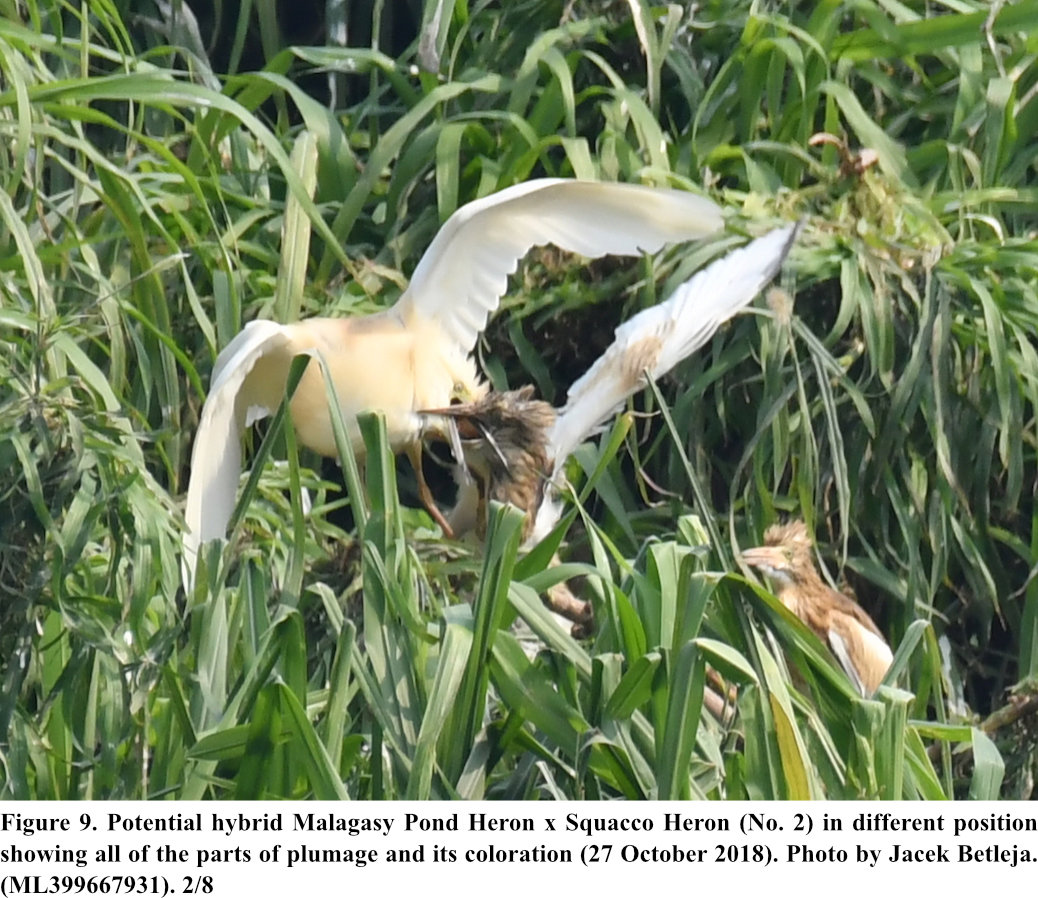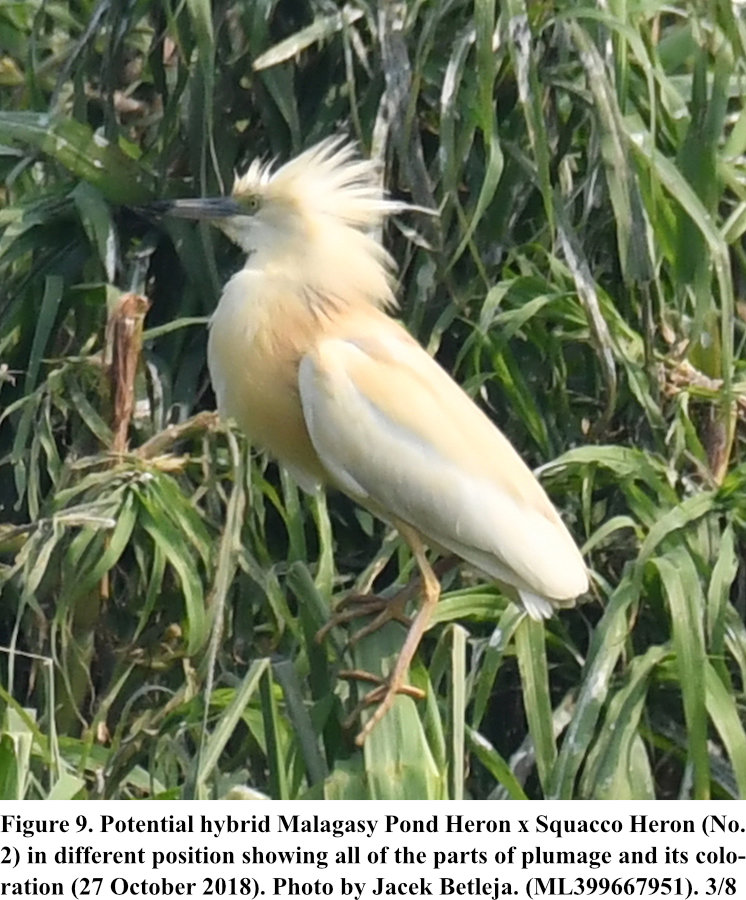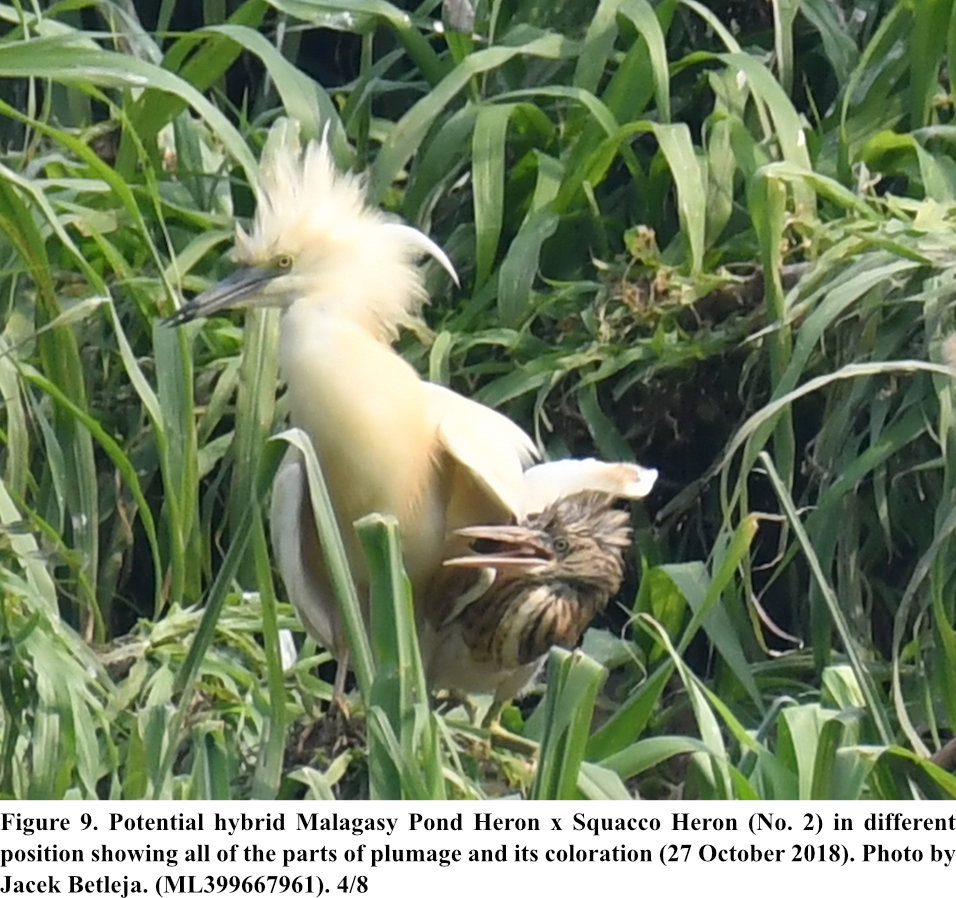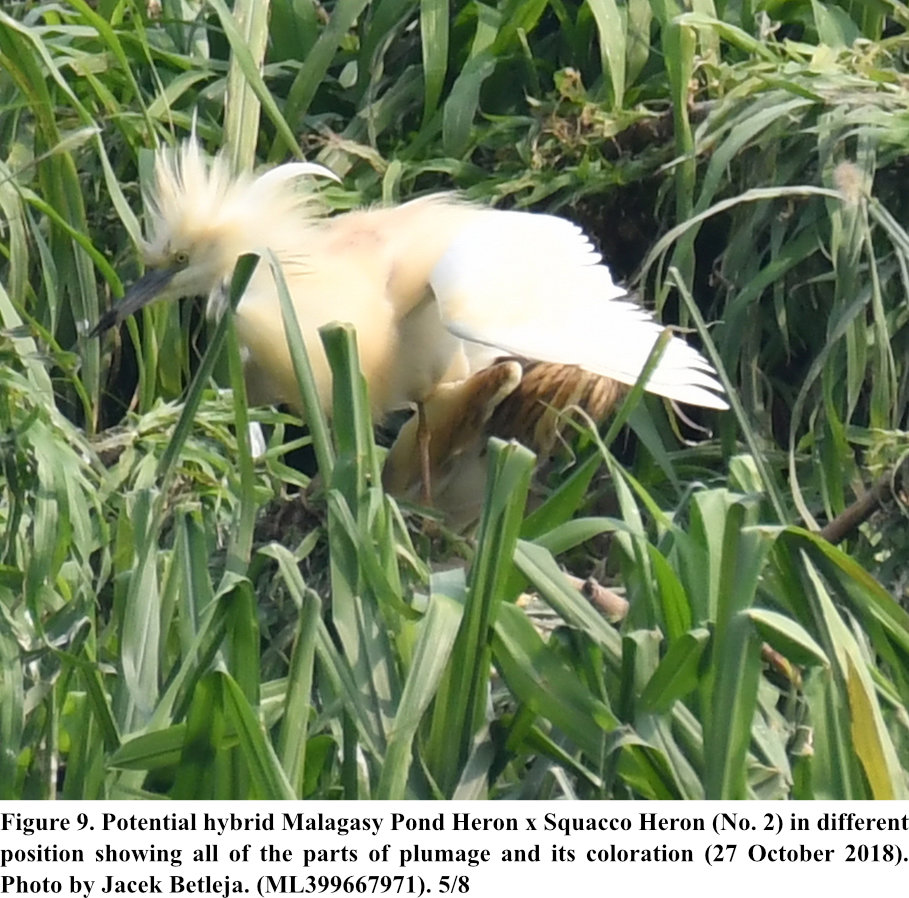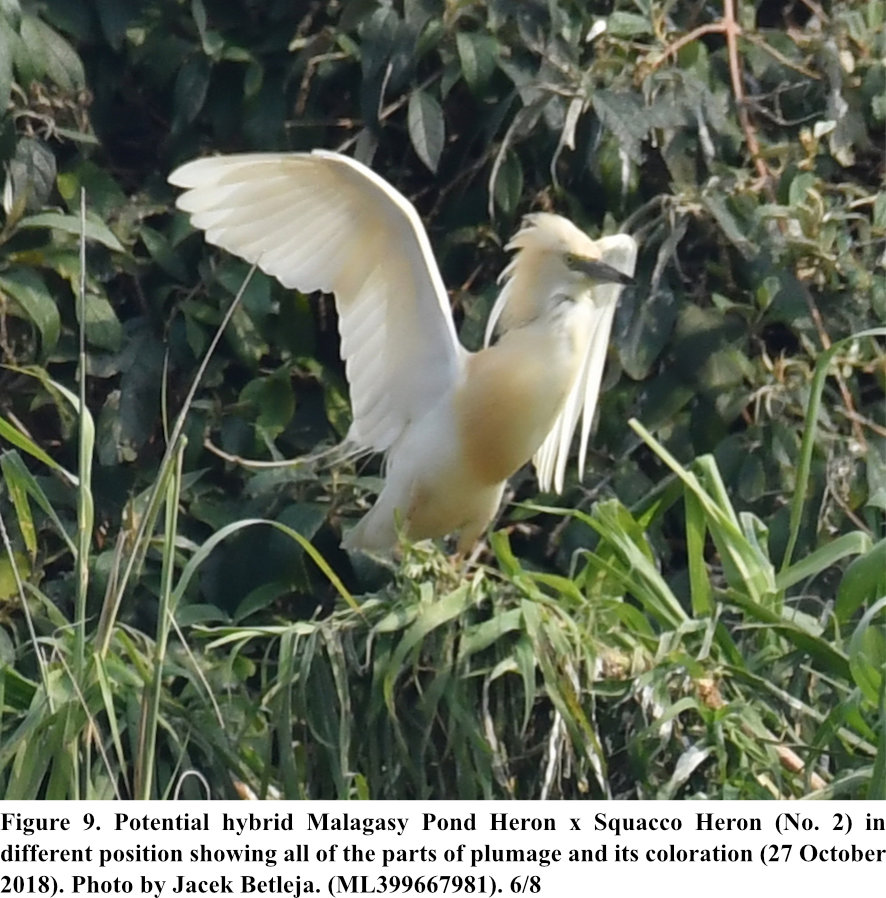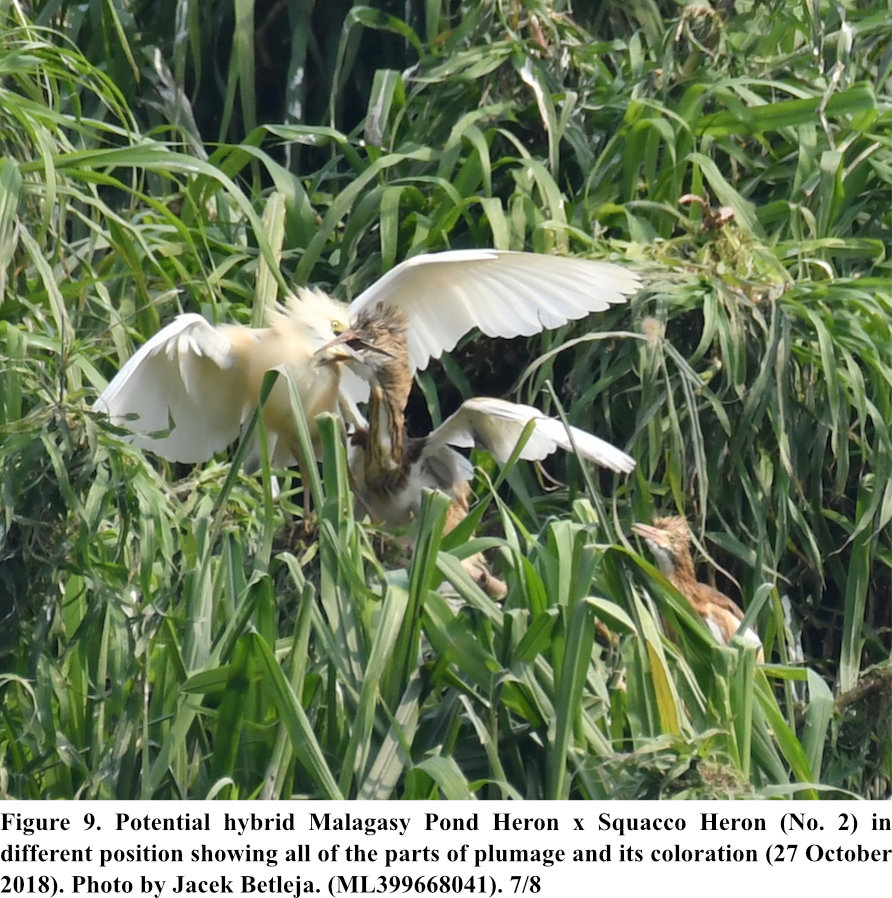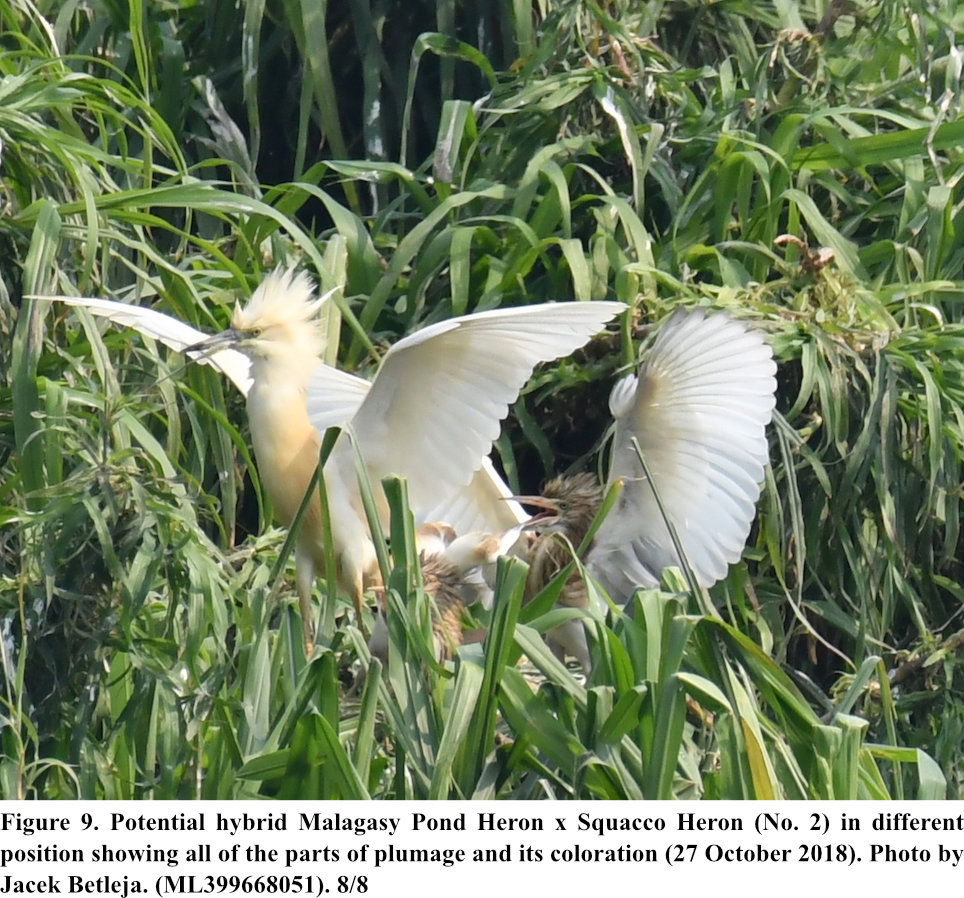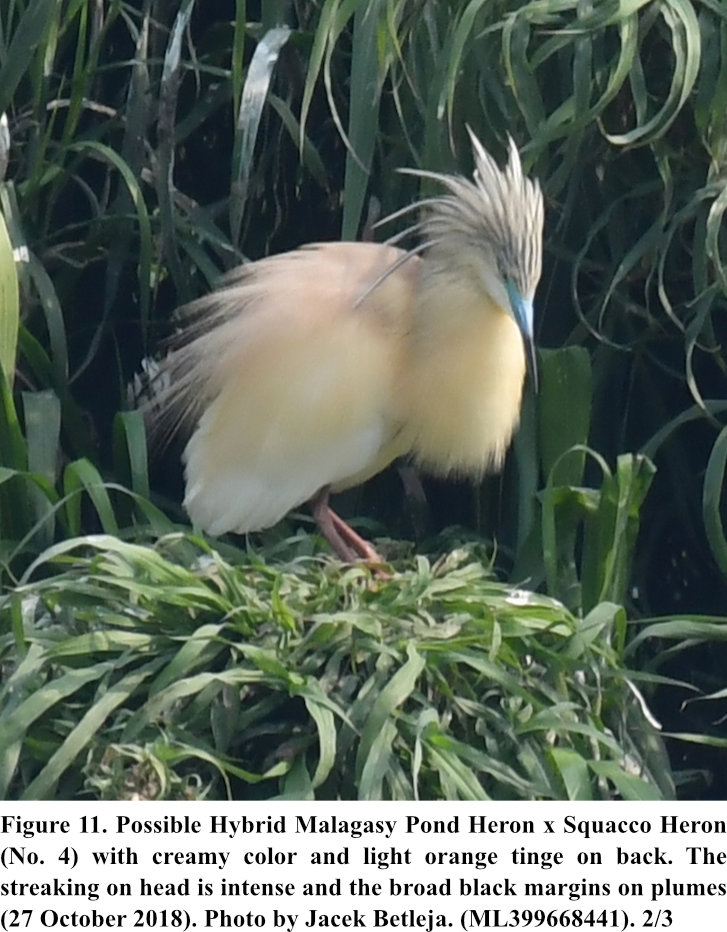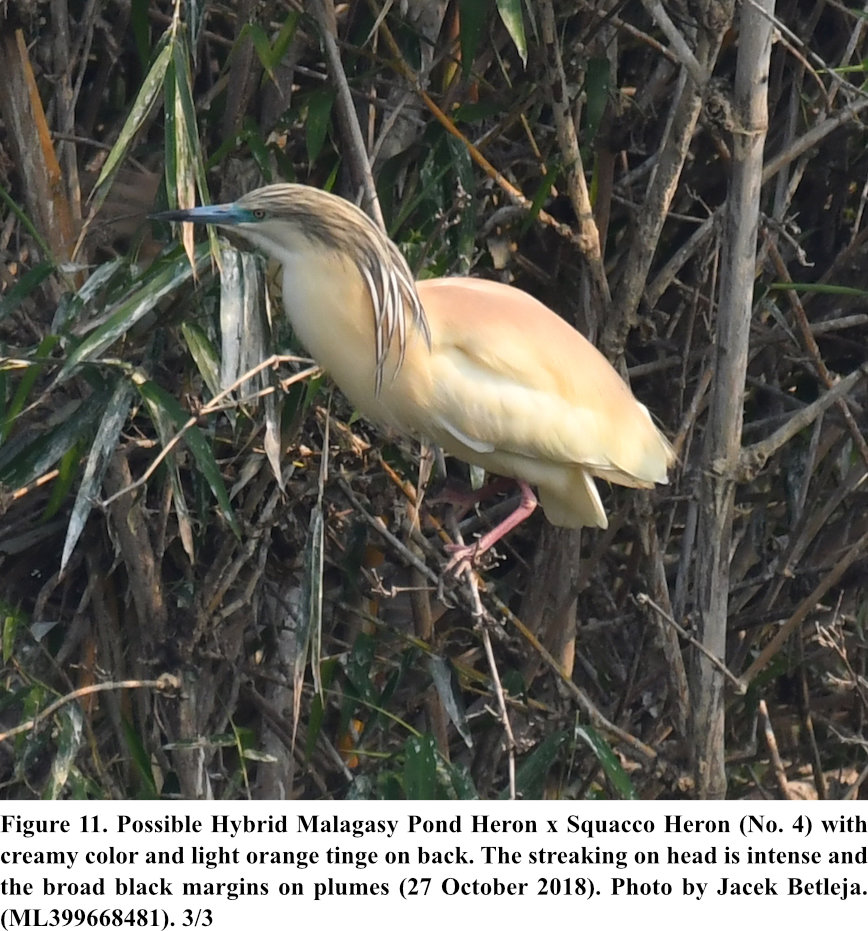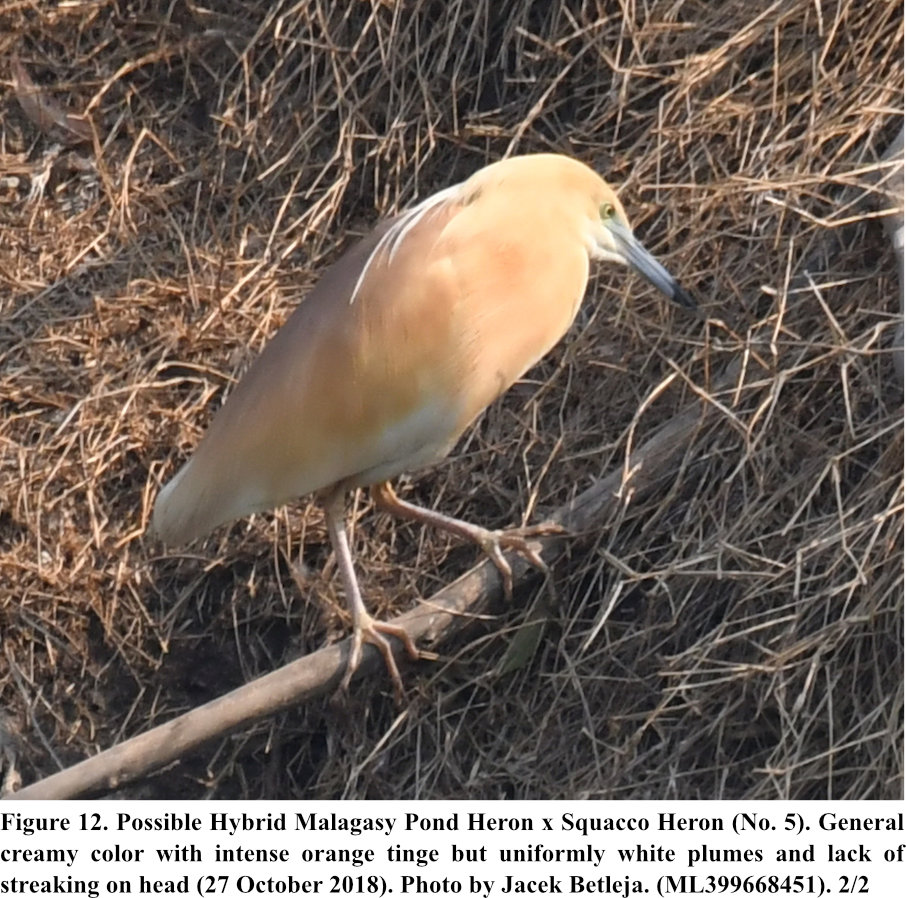Identification of potential hybrids between Malagasy Pond Heron (Ardeola idae) and Squacco Heron (A. ralloides) based on photos
Abstract
The present-day breeding population of the Malagasy Pond Heron (Ardeola idae), numbering several thousand individuals, is declining rapidly and the species is therefore Endangered. One of the threats to this species is hybridization with the Squacco Heron (Ardeola ralloides). Hybridization between these two species has not yet been fully studied, neither have such hybrids been documented or their appearance described. Hence, it is not known what features should be taken into account when identifying potential hybrids in the field. Based on analysis of the photos taken in a colony in Parc Tsarasaotra in Antananarivo, Madagascar, the birds which look like the hybrids have been recognized. As a result, a set of features has been produced for the identification of potential hybrids in adult plumage: 1. Head plumes with narrow black margins; 2. Creamy breast and back tinged orange; 3. Some but not dense streaking on the head. Further observations of atypical-looking individuals and genetic testing, in the colonies are recommended as well as in-depth research on this hybridization, which could lead to the extinction of the Malagasy Pond Heron.
Key words: Ardeidae, Ardeola idae, Ardeola ralloides, endangered species, heron hybrid, hybrid features, Malagasy Pond Heron, Squacco Heron, threats from hybridization.
Introduction
The Malagasy Pond Heron (Ardeola idae, hereafter MPH) breeds exclusively in Madagascar and nearby islands (Europa, Aldabra and Mayotte). It occurs throughout Madagascar but more so in the West than in the East or South. It winters in continental Africa, mainly in Kenya and Tanzania, but some birds remained in Madagascar and Mayotte during austral winter (Rabarisoa et al. 2020). The MPH breeding season lasts from October to March, peaking at the beginning of the rainy season in November and December. MPH is a monotypic species and probably reaches the full adult plumage at the age of 3 calendar years as other Ardeidae in this size, e.g., Black-crowned Night Heron (Nycticorax nycticorax) (Hothem et al. 2020).
The MPH was designated an Endangered species in 2004, with a sharply declining population (BirdLife International 2023). Based on surveys in the period 1993-2016, the current estimated population numbered about 1,100 breeding birds in the whole breeding area (Rabarisoa et al. 2020). One of the main reasons for declining was the expansion and displacement of MPH by the Squacco Heron (Ardeola ralloides, hereafter SH) (Martínez-Vilalta and Motis 1992, Kushlan and Hafner 2000, Rabarisoa et al. 2020).
Ndang’ang’a and Sande (2008) state that in Madagascar there is increasing evidence of hybridization with the much more common SH. They recommend undertaking research into this to determine the extent, impacts and causes of hybridization. This phenomenon, one of the five most important threats to MPH, has been repeatedly alluded to by various authors (e.g., Ndang’ang’a and Sande 2008, Safford and Hawkins 2013). However, the only confirmed record pointing to hybridization between MPH and SH seems to be the observation of these two species on one nest in the Tsimbazaza Park in January 1999, as documented in Rabarisoa et al. (2020).
Obtaining hard evidence of ongoing hybridization should be based on DNA analysis and observation of ringed birds but it needs much detailed and long-term studies. On the other hand, searching for mixed broods may turn out to be very difficult, especially if the populations of both species already contain first-generation (F1) hybrids. Hybridization between these two Ardeola species has not been fully studied, neither have such hybrids been documented or their appearance described. Taking and analyzing photos of ringed birds, especially confirmed hybrids, should be a great addition to such further research. Hence, it is not known what features should be taken into account when identifying them in the field. And for this reason, preliminary data can be used to draw attention to characteristics that may be useful in identifying potential hybrids at the beginning of detailed studies.
Similar studies, using identification from photos, are helpful in the identification of hybrids aimed at determining the threat of rare and endangered species, e,g., the Greater Spotted Eagle (Clanga clanga) (Lontkowski and Maciorowski 2010) and Mediterranean Gull (Ichthyaetus melanocephalus) (Zieliński et al. 2019). Interspecific hybridization occurs in nature surprisingly more often than might be expected (Arnold 1997). Hybridization is much more frequent when one of the species is rare, as low abundance leads to a lack of mates and is often a major trigger of hybridization. Hence, harder-to-identify hybrids between similar-looking species are rarely listed or described in publications (Randler 2006, Coulson 2019). It is generally assumed that hybrid individuals will be phenotypically intermediate between the parental individuals and also express a mixture of the parental phenotypes (McCarthy 2006). Morphological characters often do not allow one to determine whether an individual is a first-generation hybrid (F1), a backcross, or a later generation hybrid (Allendorf et al. 2001). Hybrids may also have features of extreme variations in the coloration of the parent species, although it is possible to recognize them in photos taken for precisely this (Corbeau et al. 2021).
Methods
The photographs were obtained from the heron colony in the Parc Tsarasaotra (18° 52′ 06.9″ S, 47° 31′ 03.2″ E), Antananarivo, which is often visited by birders on trips to Madagascar. This site was inspected twice on 10 and 27 October 2018, at the beginning and end of a tour of Madagascar. Each visit lasted approximately 2 hours. A Nikon D500 camera with a Nikkor 200-500 mm lens was used. Most of the photos were taken from the southern shore of the Ladybird Lake from a distance of 50 meters to the island where the herons nested (Fig. 1). The photography did not appear to scare the birds or otherwise disturb them.

On the first occasion, MPH was searched for across the entire area of the Parc Tsarasaotra reserve and the first photographs were taken. Three adult birds of MPH were found. During the second visit, the specific intention was to photograph adults of MPH and SH, specifically to highlight the differences in the coloration of breeding plumage. Individuals with an atypical appearance were photographed repeatedly from many different angles.
Individual birds were distinguished on the basis of the differences in coloration of different parts of the body, including those that are not diagnostic as regards species identification (legs, bill). More than 1,000 photos were taken during both visits, and 548 were examined in the context of MPH identification.
The following features were taken into account when analyzing the photos: the color of the breast and back, the extent of buff coloration, the colors of the head, head plumes and iris, and the wing formula. All the photos on which this article is based have been submitted to the Macaulay Library photo database. The links to the photos are thus given in the form of a unique Macaulay Library photo number.
Results
During both visits to the reserve, there was a total of about 400 herons, mainly of four species: Dimorphic Egret (Egretta dimorpha) – over 100, including already flying young birds fed by their parents; SH – c. 150 adults, Cattle Egret (Bubulcus ibis) – c. 100 adults, including some with young in the nests, and Black-crowned Night-Heron (Nycticorax nycticorax) – c. 50 adults.
During the first visit (10 October 2018), all of the heron species were photographed including typical SH (Fig. 2) in the same pose like a typical MPH (Fig. 3), for better comparison. The photographic material was obtained and revealed the presence of three adult MPHs differing in appearance. The most typical bird was uniformly white with just a slight creamy tinge on the forehead (Fig. 3). It had intensely colored non-feathered parts: red legs and toes, a black-tipped blue bill, the base of which and the skin around the eye were green. It was exhibiting courtship behavior, changing its position, leaning over and spreading its feathers over its back.


During the second visit, four pure adult MPHs were observed. One of them was in the same place where it had been seen during the first visit. It looked the same but this time was not displaying, but was sitting on a nest that had been enlarged between the first and second visits (Fig. 5).

Another bird, with uniform white plumage, was seen at another location on the island (Fig. 6).



Discussion
Hybridization is a serious problem in the protection of endangered species (Rhymer and Simberloff 1996). This is what is happening with the Greater Spotted Eagle (Clanga clanga) and Lesser Spotted Eagle (Clanga pomarina) where hybridization was an intermediate step before the disappearance of the endangered Greater Spotted Eagle in hybrid zone in Europe (Väli et al. 2010). An additional potential threat is the formation of hybrid populations that achieve better breeding success than the parent species, as demonstrated in the well-researched case of the so-called “Olympic Gull” in North America (Good et al. 2010). The current state of knowledge about MPH is that the scope, severity and impact of hybridization on this heron is unknown. (BirdLife International 2023).
Hybridization between other herons species is known, although mainly within the genera Ardea and Egretta (Kushlan and Hancock 2005). One factor that contributes to hybridization is the range expansion of one species and the consequent occupation of the breeding area of a second species (McCarthy 2006). The range expansion of one species combined with the shortage of partners in new areas may even lead to mixed broods between different genera (Egretta x Ardeola) within the family Ardeidae (Mashiko et al. 2012). Hybridization in the Antananarivo region could have taken place earlier, when atypically colored individuals were found. That could also have been reinforced by a simultaneous decrease in the population of MPH and an increase in SH (Safford and Hawkins 2013). The presence of even single hybrids in this colony could lead to backcrossing and effective introgression of SH genes into the MPH population. A possible scenario is the dissemination of MPH genes among the predominant SH, especially in this particular colony. The identification of hybrids in later years and generations of mixed individuals may turn out to be more and more difficult.
Identification of MPH and potential hybrids in all of plumages could be hard based on the descriptions and illustrations in monographs and field guides (Kushlan and Hancock 2005, Safford and Hawkins 2013, Hawkins et al. 2015). As a final result of this study, the features enabling the identification of hybrids are shown in comparison to both species (MPH and SH) (Table 1). The reference point for creating this table was the assumption that displaying adults with fully developed (blue bill, dark pink legs, breeding feathers) but atypical breeding plumage must be hybrids.
The photos were also analized in terms of other possibly useful features noted in the literature. The wing formula is different for MPH and SH (Safford and Hawkins 2013), but this feature is very difficult to observe in the field and even from photos because of the different viewing angles of the wings. The color of the iris in birds in full breeding plumage may be an auxiliary feature: pale yellow in SH but tending to be much darker in MPH. All photographed pure MPHs had dark irises. A dark iris has not yet been described as a feature of MPH in Kushlan and Hancock (2005). Nevertheless, the birds recognized as hybrids in the photos had pale yellowish irises. However, neither of these features are important when attempting to identify hybrids from a distance; at best, they may be useful for identifying birds in the hand or in close-up photos.
Future studies should require detailed observations in MPH colonies, searching for and ringing hybrids on their nests, as well as genetic analysis. The results of this work and further research will contribute to a realistic evaluation of the threat to MPH. This could lead to the implementation of new security measures in the next edition of the MPH Action Plan (Ndang’ang’a and Sande 2008).
Acknowledgments
I would like to thank all anonymous reviewers for their valuable comments and advice. Many thanks go to Gopi Sundar and the editors of Waterbirds Journal, where I submitted the first manuscript. At their suggestion, I met with Chip Weseloh and Katsutoshi Matsunaga. Thanks to their sincere help and constructive feedback, I was able to bring the publications to the final version.
Literature Cited
Allendorf, F. W., R. F. Leary, P. Spruell and J. K. Wenburg. 2001. The problems with hybrids: setting conservation guidelines. Trends in Ecology & Evolution 16: 613-622.
Arnold, M. L. 1997. Natural hybridization and evolution. Oxford University Press. New York, New York, U.S.A.
BirdLife International. 2023. Species factsheet: Ardeola idae. [online] Accessed 23 April 2023.
Corbeau, A., A. Pajot., M. Pajot., S. Peroteau and A. Jambon. 2021. Probable Black Tern x White-winged Black Tern hybrid. British Birds 114: 360-361.
Coulson, J. C. 2019. Gulls. New Naturalist Library, HarperCollins Publishers, London, U.K.
Good, T. P., J. C. Ellis, C. A. Annett and R. Pierotti. 2010. Bounded hybrid superiority in an avian hybrid zone: Effects of mate, diet and habitat choice. Evolution 54: 1774-1783.
Hawkins, F., R. Safford and A. Skerrett. 2015. Birds of Madagascar and the Indian Ocean Islands. Helm Field Guides. Bloomsbury Publishing, London, U.K.
Hothem, R. L., B. E. Brussee, W. E. Davis Jr., A. Martínez-Vilalta, A. Motis and G. M. Kirwan 2020. Black-crowned Night-Heron (Nycticorax nycticorax), version 1.0. In Birds of the World (S. M. Billerman, ed.). Cornell Lab of Ornithology, Ithaca, New York, U.S.A. [online] Accessed 14 August 2023.
Kushlan, J. A. and H. Hafner (eds.). 2000. Heron conservation. Academic Press. London, U.K.
Kushlan, J. A. and J. A. Hancock. 2005. The herons. Bird families of the world. Oxford University Press, Oxford, U.K.
Lontkowski, J. and G. Maciorowski. 2010. Identification of juvenile greater spotted eagle, lesser spotted eagle and hybrids. Dutch Birding 32: 384-397.
Martínez-Vilalta, A. and A. Motis. 1992. Family Ardeidae (Herons). Pages 376-429 in Handbook of the Birds of the World, Volume 1: Ostrich to Ducks (J. del Hoyo, A. Elliott and J. Sargatal, eds.). Lynx Editions, Barcelona, Spain.
Martínez-Vilalta, A., A. Motis and G. M. Kirwan. 2020. Squacco Heron (Ardeola ralloides), version 1.0. In Birds of the World (J. del Hoyo, A. Elliott, J. Sargatal, D. A. Christie, and E. de Juana, eds.). Cornell Lab of Ornithology, Ithaca, New York, U.S.A. [online] Accessed 14 August 2023.
Martínez-Vilalta, A., A. Motis and G. M. Kirwan. 2021. Malagasy Pond-Heron (Ardeola idae), version 1.1. In Birds of the World (J. del Hoyo, A. Elliott, J. Sargatal, D. A. Christie, and E. de Juana, eds.). Cornell Lab of Ornithology, Ithaca, New York, U.S.A. [online] Accessed 14 August 2023.
Mashiko, M., M. Fujioka, K. Moriya, T. Hagimoto, M. Yamaguchi and Y. Toquenaga. 2012. Natural Hybridization between a Little Egret (Egretta garzetta) and a Chinese Pond Heron (Ardeola bacchus) in Japan. Waterbirds 35: 160-163.
McCarthy, E. M. 2006. Handbook of avian hybrids of the world. Oxford University Press. New York, U.S.A.
Ndang’ang’a, P. K. and E. Sande. (Compilers). 2008. International Single Species Action Plan for the Madagascar Pond-heron (Ardeola idae). CMS Technical Series No. 20, AEWA Technical Series No. 39. Bonn, Germany.
Rabarisoa, R., J. Ramanampamonjy, F. Razafindrajao, L. A. Rene de Roland, F. Jeanne, O. Bacar, A. Laubin and F. Bignon. 2020. Status assessment and population of the Madagascar Pond-heron (Ardeola idae) from 1993-2016. Waterbirds 43: 45-54.
Randler, C. 2006. Behavioural and ecological correlates of natural hybridization in birds. Ibis 148: 459-467.
Rhymer, J. M. and D. Simberloff. 1996. Extinction by hybridization and introgression. Annual Review of Ecology and Systematics 27: 83-109.
Safford, R. and F. Hawkins. 2013. The Birds of Africa Volume VIII. The Malagasy Region. Christopher Helm, London, U.K.
Väli, U., V. Dombrovski, R. Treinys, U. Bergmanis, S. J. Daróczi, M. Dravecky, V. Ivanovski, J. Lontkowski, G. Maciorowski, B-U. Meyburg, T. Mizera, R. Zeitz and H. Ellegren. 2010. Widespread hybridization between the Greater Spotted Eagle Aquila clanga and the Lesser Spotted Eagle Aquila pomarina (Aves: Accipitriformes) in Europe. Biological Journal of Linnean Society 100: 725-736.
Zieliński, P., T. Iciek, M. Zielińska, J. Szymczak, M. Gajewski, D. Bukaciński, M. Bukacińska, J. Betleja, Ł. Bednarz, A. Loręcki, P. Kołodziejczyk and Ł. Ławicki. 2019. Identification of hybrids Mediterranean x Black-headed Gull in Poland. Dutch Birding 41: 318-330.




